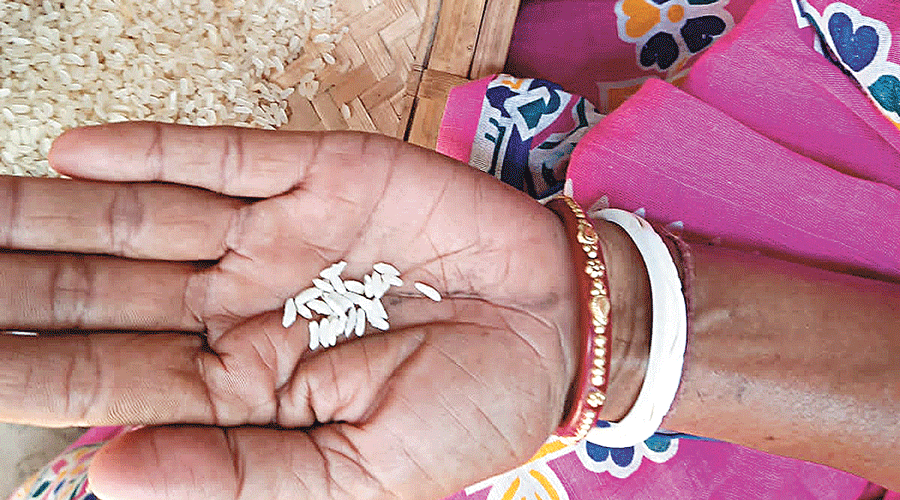A young girl and her brother from a village in Chakulia block of East Singhbhum district in Jharkhand, both suffering from sickle cell anaemia, are now in a dilemma on eating rice.
For Vandana Patro, 22, a native of Kuchiashole village in Chakulia block and her brother Biswajit Patro, 24, confusion arose after they come to know that suffering from blood disorder should consume fortified rice only under medical supervision.
“We saw the labels in the rice sacks which states that those suffering from thalassemia should consume the rice only under medical supervision. We do not have an option to consume normal rice as ration shops are giving only fortified rice. We do not have the means to purchase costly non-fortified rice from open market,” said Vandana, a BA third year student of Ghatshila College in East Singhbhum district.
Chakulia and Dhalbhumgarh are the only two blocks in Jharkhand selected for pilot project of fortified rice distribution scheme of the Central government.
Prime Minister Narendra Modi had announced from the Red Fort on the 75th Independence Day last year about fortification of rice distributed under various government schemes including public distribution system and mid-day meal by 2024.
A fact-finding team comprising members of Right To Food Campaign (RTFC) and Alliance for Sustainable & Holistic Agriculture (ASHA-Kisan Swaraj), had on Wednesday urged Jharkhand government to stop Central government’s “misadventure” with rice fortification.
The team included public health expert associated with the Right To Food Campaign, Dr Vandana Prasad, farmers’ rights activist with ASHA-Kisan Swaraj, Kavitha Kuruganti, Right to Food Campaign, Jharkhand member Balram and James Herenz, Greenpeace India member Rohin Kumar, ASHA-Kisan Swaraj member Soumik Banerjee and Raj Shekhar Singh from Right to Food Campaign National Secretariat.
The team report released in Ranchi on Wednesday points to many serious concerns with regard to indiscriminate distribution of fortified rice to poor households in the state even as there are high levels of anaemia, there is a significant proportion of Adivasi population among whom various blood disorders like thalassemia and sickle cell anaemia exist.
“For the population with these blood disorders, fortified iron is not an answer. In fact, the FSSAI’s regulations on fortified foods ask for mandatory labelling, to have a (warning) statement that asks thalassemia patients to consume such iron-fortified food under medical supervision. It further warns sickle cell anaemia patients not to consume iron-fortified food. We must stop the Central government's misadventure with fortified rice as it would lead to serious health concerns,” said Kavitha Kuruganti.
“On one hand, the government understands the health risks of consumption of iron fortified food for many people with particular health conditions in our society, and brings in regulations like this. On the other hand, the government itself is distributing such rice in all its food schemes where the poor have no option but to depend on this entitlement for their food security.
“What is more, in Jharkhand due to lack of population-based screening, people with these health conditions may not know that they have these blood disorders; further, the government is also distributing such rice without any proper information to, or dialogue with the communities,” pointed out the fact finding team.
“Fortified rice is not a proven approach to tackle anaemia effectively, as per published papers and reviews. It is surprising that the Government of India, in a hasty blanket approach, has already scaled up distribution of fortified rice to 257 districts across India, even though the so-called ‘pilots’ have not completed three years from the time initiated, nor evaluated, nor findings put out in the public domain. In Jharkhand too, official data on the government portal shows fortified rice being distributed in two blocks of Chakulia and Dhalbhumgarh in East Singhbhum (the designated pilot district in the state) only from October 2021. However, without any data being shared on the portal of the distribution in other districts, fortified rice has already been taken to several districts. What is the purpose of the pilot then?” asked Kavitha.
“In Jharkhand, civil society groups have already demonstrated there are effective ways of dealing with nutrition holistically. Local, diverse foods (including uncultivated forest foods and traditional crops and varieties) play a key role, along with participatory learning in these community-led approaches. The government has to expand its food security basket to include millets, pulses, eggs, cooking oil and milk in the food schemes,” the report recommend.










